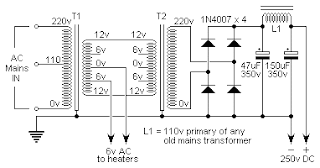
Here is a rather novel Power Supply Unit (PSU) for the workbench which can deliver 0-15 volts and up to 0-3 amperes. I have not shown any mains fuses as this I will leave to your own devices. You should as a minimum have a fuse in the primary and secondary of T1.

The circuit is a little cramped, but this is because I will also be posting the circuit to QRP@WW on the packet radio system. There are two resistors in the circuit marked "*see text" and these set the maximum output current limiter to a suitable value. Omit the 0R2 resistor and the PSU will deliver 100mA maximum. In this event the output TR8 can be almost any medium power transistor such as the 2N3053, BFY51 etc. It must be mounted on a heatsink no matter what output you need.
The 6R8 resistor may be an ordinary 1/4 watt resistor and is used on all versions of the PSU. The additional 0R2 (0.2 ohms) sets the maximum current limiting to about 3 amperes. If you only want a 0-1 ampere PSU then use 0.68 ohms. T1 is a simple transformer suitably rated for the output power you want and having a 15 volt secondary. This should give over 21v of DC when rectified (measured at D1 cathode - ground). The anode of D7 should also have -21 volts with respect to ground.
If you have problems getting a 15 volt transformer then you can use a 12-volt transformer and add a few extra turns to the secondary. Most transformers have enough room for you to thread another 20 turns of wire through the former to put in series with the secondary winding. By sure to use the same thickness of wire as used for the factory made secondary.
D1, D2, D3, D4, D5, D6, D7 and D8 are all 1N4001 or better for up to 500mA but 1N5401 should be used if you want up to 3 amperes. D9 and D10 may be almost any small silicon diode such as 1N4148 etc. The 1K0 potentiometer in parallel with D9 is the current set pot. The 47K pot is the output voltage pot. With the values shown you should be able to get a range of 0v to a little over 15v.
HOW IT WORKS
TR4 and TR5 compare the ground (0v) with the wiper of the 47K pot which should also be 0v. If the voltages are not equal then TR5 controls the output darlington (TR6 and TR7) until the voltages become equal. If the 47K pot is set to maximum (top) then the output voltage of the PSU must be zero in order to get a balance. If the output voltage pot is set to the bottom then the voltage balance will only occur if there is +15 volts on the top of the 47K pot; the other end of the 15K being -5v.
In the event TR7 draws too much current then the voltage drop accross the 6R8 resistor will turn on TR1 which in turn turns on TR2. TR2 sinks the 0v reference to -20 volts. The TIP41 is incapable of delivering a negative output voltage so the output remains at 0v. The base of TR1 is "lifted" by up to 0.7v due to the current flowing through D10. This overcomes the TR1 base-emitter voltage drop needed to turn it on. You can adjust the 22K resistor a little so that the current control goes all the way down to 0mA and no further. 5K6 is about the absolute minimum resistance you should use.
The power supply itself is very simple and is nothing more than a full-wave bridge rectifier. The AC from the transformer is also capacitively coupled to yet another rectifier to provide the negative voltage required to allow the PSU to be controlled down to 0 volts. TR3 regulates this to stabilise the negative reference voltage.
POSSIBLE PROBLEMS
In the event of self-oscillation of the PSU then under no circumstances put any capacitance accross any signal in the control path. This will just make the problem worse. The cure for this would be to add capacitance between the base/emitter of the controlling transistors TR4 and TR5.
SUGGESTED MODIFICATION
One modification I have thought about is to replace the 22uf in the base of TR4 with a smaller value, say 10nf, and couple audio into the base of TR4 with a large electrolytic (1uf should do it). This will allow the output voltage of the PSU to be modulated with an audio signal. This could be a very interesting modification if you are "into" AM (MW?) broadcasting.
Source : http://web.telia.com/~u85920178/use/psu2.htm
BENCH PSU
by Harry Lythall - SM0VPO
Labels: Power Supply








